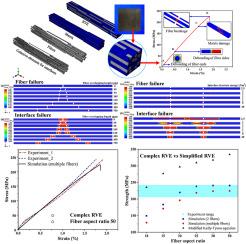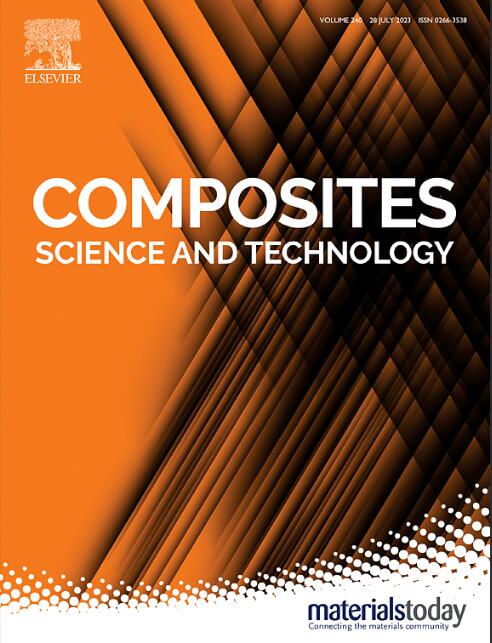单向(UD)非连续亚麻纤维增强复合材料的微机械分析
IF 8.3
1区 材料科学
Q1 MATERIALS SCIENCE, COMPOSITES
引用次数: 0
摘要
由于纤维长宽比大、纤维长度分布不均匀以及界面建模等原因造成的计算困难,预测天然纤维复合材料的强度和损伤行为是一项具有挑战性的任务。受伦纳德-琼斯势能的启发,本研究开发了一种计算微观力学模型,通过采用一种新颖的代表体积元素(RVE)生成算法来解决上述难题,从而预测单向(UD)亚麻/环氧复合材料的拉伸行为。利用该数值模型广泛研究了纤维长径比、纤维空间分布、界面和基体特性对亚麻/环氧复合材料纵向模量、强度和损伤行为的影响。将数值模型预测的模量和强度与分析模型和实验结果进行了比较,不仅验证了数值模型,而且发现了分析模型的局限性。亚麻/环氧复合材料的纵向强度最初随纤维纵横比的增加而增加。当达到一定的纤维纵横比(本研究中为 25)时,RVE(多纤维 RVE)和单元格(双纤维单元格)预测的强度都接近实验值(240 兆帕)。这一发现为如何使用简化的单元格来预测天然纤维复合材料的强度提供了信心和指导,其精度可以接受,计算成本更低。本文章由计算机程序翻译,如有差异,请以英文原文为准。

Micromechanical analyses of unidirectional (UD) discontinuous flax fiber reinforced composites
Prediction of the strength and damage behavior of natural fiber composites is a challenging task due to computational difficulties resulting from large fiber aspect ratio, non-uniform fiber length distribution, and interface modelling. A computational micromechanical model, which solves the above-mentioned challenges by incorporating a novel representative volume element (RVE) generation algorithm inspired by Lennard-Jones potential, is developed to predict the tensile behavior of unidirectional (UD) flax/epoxy composites. Effects of fiber aspect ratio, fiber spatial distribution, interfacial and matrix properties on longitudinal modulus, strength, and the damage behavior of the flax/epoxy composites are extensively studied using the numerical model. The modulus and strength predicted by numerical model were compared with both analytical models and experimental results, which not only validated the numerical model but identified the limitations of analytical model. The longitudinal strength of flax/epoxy composites initially increased with fiber aspect ratio. Upon reaching certain fiber aspect ratio (25 in this study), strength predicted by both RVE (RVEs with many fibers) and unit cell (unit cells with two fibers) are close to experimental value (240 MPa). This finding provides confidence and guidance on how to use simplified unit cells to predict the strength of natural fiber composites with acceptable accuracy and much lower computational cost.
求助全文
通过发布文献求助,成功后即可免费获取论文全文。
去求助
来源期刊

Composites Science and Technology
工程技术-材料科学:复合
CiteScore
16.20
自引率
9.90%
发文量
611
审稿时长
33 days
期刊介绍:
Composites Science and Technology publishes refereed original articles on the fundamental and applied science of engineering composites. The focus of this journal is on polymeric matrix composites with reinforcements/fillers ranging from nano- to macro-scale. CSTE encourages manuscripts reporting unique, innovative contributions to the physics, chemistry, materials science and applied mechanics aspects of advanced composites.
Besides traditional fiber reinforced composites, novel composites with significant potential for engineering applications are encouraged.
 求助内容:
求助内容: 应助结果提醒方式:
应助结果提醒方式:


